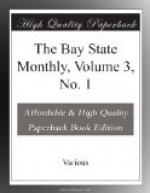In October Mr. Coffin was once more in Kentucky, but did not reach the army in season to see the battle of Perrysville. Comprehending the situation of affairs there, that there could be no movement until the entire army was re-organized under a new commander, he returned to Virginia, accompanying the army in its march from the Potomac to Fredericksburg, and witnessed that disastrous battle. A month later he was with the fleet off Charleston and saw the attack on Sumter by the Monitor, and the bombardment of Fort McAllister.
In April he was once more with the Army of the Potomac, arriving just as the troops were getting back to their quarters after Chancellorsville to hear the stories and collect an account of that battle.
When the Confederate army began the Gettysburg Campaign Mr. Coffin watched every movement. He was with the cavalry during the first day’s struggle on that field, but was an eyewitness of the second and third days’ engagement. His account was re-published in nearly every one of the large cities, was translated and re-published in France and Germany. While the armies east and west were preparing for the campaign of 1864 Mr. Coffin made an extended tour through the border states—Maryland, West Virginia, Kentucky, Missouri, Kansas, Illinois, Indiana, and Ohio, to ascertain what changes had taken place in public opinion. In May he was once more with the Army of the Potomac under its great leader, Lieutenant General Grant, and saw all the conflicts of the Wilderness, Spottsylvania, North Anna, around Hanover, Cold Harbor, the struggles in front of Petersburg through ’64. Upon the occupation of Savannah by General Sherman he hastened south, having an ardent desire to enter Charleston, whenever it should be occupied by Union troops. He was successful in carrying out his desires, and with James Redpath of the New York Tribune leaped on shore from the deck of General Gilmore’s steamer when he steamed up to take possession of the city.
Mr. Coffin’s despatch announcing the evacuation and occupation of Sumter, owing to his indefatigable energy, was published in Boston, telegraphed to Washington, and read in the House of Representatives before any other account appeared, causing a great sensation.
Thus read the opening sentence:
“Off Charleston, February 18, 2 P.M. The old flag waves over Sumter and Moultrie, and the city of Charleston. I can see its crimson stripes and fadeless stars waving in the warm sunlight of this glorious day. Thanks be to God who giveth us the victory.”
In March the correspondent was again with the Army of the Potomac, witnessing the last battles—Fort Steadman—Hatcher’s Run—and the last grand sweep at Five Forks. He entered Petersburg in the morning—rode alone at a breakneck pace to Richmond, entering it while the city was a sea of flame, entered the Spottsville hotel while the fire was raging on three sides—wrote his name large on the register—the first to succeed a long line of Confederate Generals and Colonels. When President Lincoln arrived to enter the city, he had the good fortune to be down by the river bank, and to him was accorded the honor of escorting the party to General Weitzel’s headquarters in the mansion from which Jefferson Davis had fled without standing upon the order of departure.




